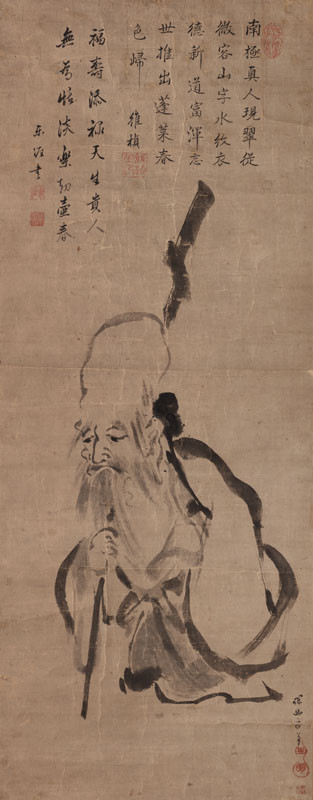
The motif of this vertical composition is one of the Seven Gods of Fortune, Jurōjin, a god and traditional symbol of longevity in China and Japan. In China, he is known as the personification of the Southern Polar Star, an “old man from the Southern Pole”. The figure’s reverse bears the inscription “drawing of Jurōjin from the Southern Pole” (Nankyoku Jurōjin no zu). The scroll is signed “Tan’yū’s brush” (Tan’yūsai hitsu) and bears the seal Seimei in a gourd-shaped field (Seimei was one of Tan’yū’s artistic pseudonyms) and Tan’ū in a vermilion square seal. This time, the painter diverted from the conventional rendition of Jurōjin as a smiling friendly old man, capturing him instead as a pensive, tired old man leaning on his cane, his face reflecting wisdom and the burden of the many years he has lived. Although it is not a portrait in the true sense of the word, as its model is a mythical figure, it is an example of an outstanding artwork bordering on a psychological study, whose original approach to the theme and original brushwork represent the figural work of Kanō Tan’yū (1602–1674). He followed the older tradition of Japanese ink painting rooted in the milieu of the Japanese Zen monasteries of the Kamakura and Muromachi periods. This tradition was greatly influenced by the late 15th-century painter Sesshū. It can be assumed that Tan’yū’s rendition of Jurōjin was inspired by Sesshū’s identically-themed work now in the Boston Museum. The artwork, done in the perpendicular brush technique typical of the Kanō school, shows a steady hand and quick vigorous stroke. The colour and modulation of ink line and its playful but well-balanced rhythm attest to Tan’yū’s mastery. The dedication colophons in the form of two poems inspired by the figure of Jurōjin and written in classical Chinese by two major Japanese neo-Confucian scholars and leading representatives of the intellectual circle in Kyoto – Itō Jinsai (1627–1705) and his son Itō Tōgai (1670–1736) – were likely only added to the scroll after Tan’yū’s death. It therefore symbolizes a connection between two major elements of the official culture of the Edo period (1603–1868) – neo-Confucianism, which was preferred by the state, and the Kanō school, the official painting academy, which was headed by Kanō Tan’yū and supported by the shogunate.
